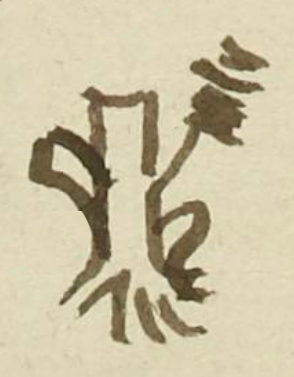Cuauh (MH577r)
This black-line drawing of the compound glyph for the personal name Cuauh ("Eagle" or “Tree,” attested here as a man’s name) shows a frontal view of a tree trunk, with branches that have been partially cut off and with roots showing. One living thing coming off this tree (cuahuitl) is a sprig of amaranth (huauhtli), which is there to serve as a phonetic indicator, aiding in the reading of the name as Cuauh and not some other term for tree. Alternatively, this name Cuauh is short for cuauhtli (Eagle), a personal name that came from the 260-day religious divinatory calendar, and the tree is just a phonetic indicator.
Stephanie Wood
This Nahua name is preceded in the gloss by a Christian first name (Toribio). He may have been named after Toribio de Benavente, also known as Motolinia ("One Who is Poor or Afflicted"). This was the first word he learned in Nahuatl, and he went on to learn the language well. He lived in the monastery in Huejotzingo. Doing a quick search for the name "Toribio" will produce an impressive result.
Stephanie Wood
doribio.guauh
Toribio Cuauh
Stephanie Wood
1560
Jeff Haskett-Wood
plants, plantas, los bledos

huauh(tli), amaranth, https://nahuatl.wired-humanities.org/content/huauhtli
cuahu(itl), tree, https://nahuatl.wired-humanities.org/content/cuahuitl-1
cuauh(tli) eagle, https://nahuatl.wired-humanities.org/content/cuauhtli
El Águila, El Árbol, o Los Bledos
Stephanie Wood
Matrícula de Huexotzinco, folio 577r, https://www.loc.gov/resource/gdcwdl.wdl_15282/?sp=233&st=image
This manuscript is hosted by the Library of Congress and the World Digital Library; used here with the Creative Commons, “Attribution-NonCommercial-ShareAlike 3.0 License” (CC-BY-NC-SAq 3.0).


